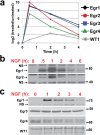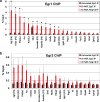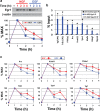Role for Egr1 in the Transcriptional Program Associated with Neuronal Differentiation of PC12 Cells
- PMID: 28076410
- PMCID: PMC5226839
- DOI: 10.1371/journal.pone.0170076
Role for Egr1 in the Transcriptional Program Associated with Neuronal Differentiation of PC12 Cells
Abstract
PC12 cells are a well-established model to study how differences in signal transduction duration can elicit distinct cell behaviors. Epidermal growth factor (EGF) activates transient ERK signaling in PC12 cells that lasts 30-60 min, which in turn promotes proliferation; nerve growth factor (NGF) activates more sustained ERK signaling that lasts 4-6 h, which in turns induces neuronal differentiation. Data presented here extend a previous study by Mullenbrock et al. (2011) that demonstrated that sustained ERK signaling in response to NGF induces preferential expression of a 69-member gene set compared to transient ERK signaling in response to EGF and that the transcription factors AP-1 and CREB play a major role in the preferential expression of several genes within the set. Here, we examined whether the Egr family of transcription factors also contributes to the preferential expression of the gene set in response to NGF. Our data demonstrate that NGF causes transient induction of all Egr family member transcripts, but a corresponding induction of protein was detected for only Egr1 and 2. Chromatin immunoprecipitation experiments provided clearest evidence that, after induction, Egr1 binds 12 of the 69 genes that are preferentially expressed during sustained ERK signaling. In addition, Egr1 expression and binding upstream of its target genes were both sustained in response to NGF versus EGF within the same timeframe that its targets are preferentially expressed. These data thus provide evidence that Egr1 contributes to the transcriptional program activated by sustained ERK signaling in response to NGF, specifically by contributing to the preferential expression of its target genes identified here.
Conflict of interest statement
The authors have declared that no competing interests exist.
Figures





Similar articles
-
Global expression analysis identified a preferentially nerve growth factor-induced transcriptional program regulated by sustained mitogen-activated protein kinase/extracellular signal-regulated kinase (ERK) and AP-1 protein activation during PC12 cell differentiation.J Biol Chem. 2011 Dec 30;286(52):45131-45. doi: 10.1074/jbc.M111.274076. Epub 2011 Nov 7. J Biol Chem. 2011. PMID: 22065583 Free PMC article.
-
Nerve growth factor- and epidermal growth factor-regulated gene transcription in PC12 pheochromocytoma and INS-1 insulinoma cells.Eur J Cell Biol. 2000 Dec;79(12):924-35. doi: 10.1078/0171-9335-00126. Eur J Cell Biol. 2000. PMID: 11152283
-
Sustained activation of M-Ras induced by nerve growth factor is essential for neuronal differentiation of PC12 cells.Genes Cells. 2006 Sep;11(9):1097-113. doi: 10.1111/j.1365-2443.2006.01002.x. Genes Cells. 2006. PMID: 16923128
-
Early growth response 1 (EGR1) activation in initial stages of host-pathogen interactions.Mol Biol Rep. 2021 Mar;48(3):2935-2943. doi: 10.1007/s11033-021-06305-0. Epub 2021 Mar 30. Mol Biol Rep. 2021. PMID: 33783681 Review.
-
Role of early growth response 1 in inflammation-associated lung diseases.Am J Physiol Lung Cell Mol Physiol. 2023 Aug 1;325(2):L143-L154. doi: 10.1152/ajplung.00413.2022. Epub 2023 Jul 4. Am J Physiol Lung Cell Mol Physiol. 2023. PMID: 37401387 Free PMC article. Review.
Cited by
-
Differential Interleukin-2 Transcription Kinetics Render Mouse but Not Human T Cells Vulnerable to Splicing Inhibition Early after Activation.Mol Cell Biol. 2019 Jul 29;39(16):e00035-19. doi: 10.1128/MCB.00035-19. Print 2019 Aug 15. Mol Cell Biol. 2019. PMID: 31160491 Free PMC article.
-
Midnolin, a Genetic Risk Factor for Parkinson's Disease, Promotes Neurite Outgrowth Accompanied by Early Growth Response 1 Activation in PC12 Cells.Mol Cell Biol. 2024;44(11):516-527. doi: 10.1080/10985549.2024.2399358. Epub 2024 Sep 12. Mol Cell Biol. 2024. PMID: 39264361 Free PMC article.
-
PLCβ1 by-passes early growth response -1 to induce the differentiation of neuronal cells.Cell Death Discov. 2024 May 24;10(1):250. doi: 10.1038/s41420-024-02009-z. Cell Death Discov. 2024. PMID: 38789419 Free PMC article.
-
Mechanistic regulation of SPHK1 expression and translocation by EMAP II in pulmonary smooth muscle cells.Biochim Biophys Acta Mol Cell Biol Lipids. 2020 Dec;1865(12):158789. doi: 10.1016/j.bbalip.2020.158789. Epub 2020 Aug 7. Biochim Biophys Acta Mol Cell Biol Lipids. 2020. PMID: 32771459 Free PMC article.
-
Nicotine, THC, and Dolutegravir Modulate E-Cigarette-Induced Changes in Addiction- and Inflammation-Associated Genes in Rat Brains and Astrocytes.Brain Sci. 2023 Nov 7;13(11):1556. doi: 10.3390/brainsci13111556. Brain Sci. 2023. PMID: 38002516 Free PMC article.
References
-
- Greene LA, Tischler AS. Establishment of a noradrenergic clonal line of rat adrenal pheochromocytoma cells which respond to nerve growth factor. Proceedings of the National Academy of Sciences of the United States of America. 1976;73(7):2424–8. Epub 1976/07/01. PubMed Central PMCID: PMC430592. - PMC - PubMed
-
- Pang L, Sawada T, Decker SJ, Saltiel AR. Inhibition of MAP kinase kinase blocks the differentiation of PC-12 cells induced by nerve growth factor. The Journal of biological chemistry. 1995;270(23):13585–8. - PubMed
MeSH terms
Substances
Grants and funding
LinkOut - more resources
Full Text Sources
Other Literature Sources
Molecular Biology Databases
Miscellaneous

